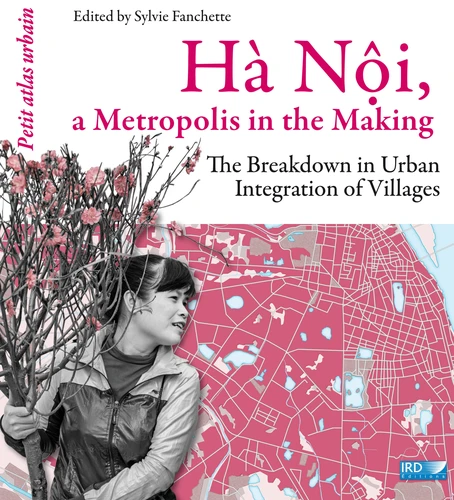Hà Nội, a Metropolis in the Making. The Breakdown in Urban Integration of Villages
Par :Formats :
Disponible dans votre compte client Decitre ou Furet du Nord dès validation de votre commande. Le format Multi-format est :
- Pour les liseuses autres que Vivlio, vous devez utiliser le logiciel Adobe Digital Edition. Non compatible avec la lecture sur les liseuses Kindle, Remarkable et Sony
 , qui est-ce ?
, qui est-ce ?Notre partenaire de plateforme de lecture numérique où vous retrouverez l'ensemble de vos ebooks gratuitement
Pour en savoir plus sur nos ebooks, consultez notre aide en ligne ici
- Nombre de pages194
- FormatMulti-format
- ISBN978-2-7099-2198-5
- EAN9782709921985
- Date de parution19/11/2018
- Protection num.NC
- Infos supplémentairesMulti-format incluant PDF avec W...
- ÉditeurIRD Editions
Résumé
Built on 'the bend in the Red River', Hà N?i is among Southeast Asia's most ancient capitals. Over the centuries, it took shape in part from a dense substratum of villages. With the economic liberalisation of the 1980s, it encountered several obstacles to its expansion: absence of a real land market, high population densities, the government's food self-suffciency policy that limits expropriations of land and the water management constraints of this very vulnerable delta.
Since the beginning of the new millennium, the change in speed brought about by the state and by property developers in the construction and urban planning of the province-capital poses the problem of integration of in situ urbanised villages, the importance of preserving a green belt around Hà N?i and the necessity of protection from flooding. The harmonious fusion of city and countryside, which has always constituted the Red River Delta's defining feature, appears to be in jeopardy.
Working from a rich body of maps and field studies, this collective work reveals how this grass-roots urbanisation encounters 'top-down' urbanisation, or metropolisation. By combining a variety of disciplinary approaches on several different scales, through a study of spatial issues and social dynamics, this atlas not only enables the reader to gauge the impact of major projects on the lives of villages integrated into the city's fabric but also to re-establish the peri-urban village stratum as a fully-fledged actor in the diversity of this emerging metropolis.
Since the beginning of the new millennium, the change in speed brought about by the state and by property developers in the construction and urban planning of the province-capital poses the problem of integration of in situ urbanised villages, the importance of preserving a green belt around Hà N?i and the necessity of protection from flooding. The harmonious fusion of city and countryside, which has always constituted the Red River Delta's defining feature, appears to be in jeopardy.
Working from a rich body of maps and field studies, this collective work reveals how this grass-roots urbanisation encounters 'top-down' urbanisation, or metropolisation. By combining a variety of disciplinary approaches on several different scales, through a study of spatial issues and social dynamics, this atlas not only enables the reader to gauge the impact of major projects on the lives of villages integrated into the city's fabric but also to re-establish the peri-urban village stratum as a fully-fledged actor in the diversity of this emerging metropolis.
Built on 'the bend in the Red River', Hà N?i is among Southeast Asia's most ancient capitals. Over the centuries, it took shape in part from a dense substratum of villages. With the economic liberalisation of the 1980s, it encountered several obstacles to its expansion: absence of a real land market, high population densities, the government's food self-suffciency policy that limits expropriations of land and the water management constraints of this very vulnerable delta.
Since the beginning of the new millennium, the change in speed brought about by the state and by property developers in the construction and urban planning of the province-capital poses the problem of integration of in situ urbanised villages, the importance of preserving a green belt around Hà N?i and the necessity of protection from flooding. The harmonious fusion of city and countryside, which has always constituted the Red River Delta's defining feature, appears to be in jeopardy.
Working from a rich body of maps and field studies, this collective work reveals how this grass-roots urbanisation encounters 'top-down' urbanisation, or metropolisation. By combining a variety of disciplinary approaches on several different scales, through a study of spatial issues and social dynamics, this atlas not only enables the reader to gauge the impact of major projects on the lives of villages integrated into the city's fabric but also to re-establish the peri-urban village stratum as a fully-fledged actor in the diversity of this emerging metropolis.
Since the beginning of the new millennium, the change in speed brought about by the state and by property developers in the construction and urban planning of the province-capital poses the problem of integration of in situ urbanised villages, the importance of preserving a green belt around Hà N?i and the necessity of protection from flooding. The harmonious fusion of city and countryside, which has always constituted the Red River Delta's defining feature, appears to be in jeopardy.
Working from a rich body of maps and field studies, this collective work reveals how this grass-roots urbanisation encounters 'top-down' urbanisation, or metropolisation. By combining a variety of disciplinary approaches on several different scales, through a study of spatial issues and social dynamics, this atlas not only enables the reader to gauge the impact of major projects on the lives of villages integrated into the city's fabric but also to re-establish the peri-urban village stratum as a fully-fledged actor in the diversity of this emerging metropolis.











